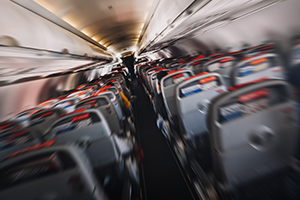Airline Turbulence Injuries
 Turbulence may feel routine when flying, but in some cases, it can lead to serious injuries. You might be seated when the plane suddenly drops, or walking down the aisle when a jolt sends you flying. These injuries often come without warning and may result in concussions, broken bones, or worse. If flight attendants do not secure carts or warn passengers, those failures may point to airline negligence. When that happens, you should not have to carry the financial burden alone.
Turbulence may feel routine when flying, but in some cases, it can lead to serious injuries. You might be seated when the plane suddenly drops, or walking down the aisle when a jolt sends you flying. These injuries often come without warning and may result in concussions, broken bones, or worse. If flight attendants do not secure carts or warn passengers, those failures may point to airline negligence. When that happens, you should not have to carry the financial burden alone.
At Friedman Rodman Frank & Estrada, we help passengers hold airlines accountable after in-flight turbulence injuries. Our firm has represented injury victims across Florida since 1976. We understand how to prove airline liability, deal with international regulations, and push back against low settlement offers. If you were hurt during turbulence, you may be entitled to compensation for your medical bills, lost income, and pain and suffering.
How Airline Negligence Contributes to Turbulence InjuriesWhile no one can prevent weather-related turbulence, airlines still have a duty to minimize your risk. When they fail to do that, passengers can suffer avoidable injuries. Common mistakes that may point to negligence include:
- Crew failing to issue seatbelt warnings in time
- Beverage or food carts left unsecured during turbulence
- Overhead bins not properly latched
- Poor training or communication among crew members
- Failure to cancel drink or meal service despite forecasts of rough air
Even when the turbulence itself is unavoidable, these lapses can lead directly to injuries. A personal injury attorney with airline experience can help you determine whether the airline’s actions violated safety standards.
Common Injuries Linked to In-Flight TurbulenceTurbulence-related injuries can range from minor to life-altering. Some of the most frequently reported injuries include:
- Head trauma or concussion from striking overhead bins or the ceiling
- Neck and back injuries caused by whiplash-style motion
- Fractures or sprains from falls or being thrown into seats or aisles
- Cuts and bruises from food carts, service trays, or other objects
- Emotional trauma from severe, violent jolts or emergency landings
Severe turbulence has even led to passenger fatalities in rare cases, particularly when individuals were unbelted during sudden altitude drops.
Why Early Documentation Strengthens Your CaseBuilding a strong airline injury claim starts with timely and thorough documentation. Airlines and their insurers often argue that injuries happened after the flight or were caused by something else entirely. To counter this, you need proof that the injury occurred on board and was connected to conditions the airline should have controlled.
Ask the crew to document the injury immediately. This creates an official record that may be critical later. Seek medical attention as soon as possible, even if you feel fine at first—some symptoms take time to appear, and quick treatment connects your injuries directly to the flight.
Take clear photos of anything that contributed to the incident. That could include spilled beverages, unsecured food carts, loose seat parts, or broken overhead bins. Get names of witnesses, including flight crew and nearby passengers who saw what happened. Request a copy of the airline’s incident report if one was prepared.
Finally, do not sign any airline paperwork or give statements until you speak to a lawyer who understands airline injury cases. The best airline injury attorneys know how to protect your rights, preserve key evidence, and determine whether international rules like the Montreal Convention apply to your claim.
How the Montreal Convention May Affect Your CaseIf your flight was international or part of a longer journey that included international legs, the Montreal Convention may apply. This treaty creates a strict-liability standard for airline injuries that occur during the course of international travel. That means the airline may be automatically responsible for physical injuries unless it can prove the injury was not caused by an "accident" under the treaty.
The benefit of this rule is that you do not always have to prove fault—just that the injury occurred during the flight and was tied to an unexpected or unusual event. For instance, sudden turbulence that causes a passenger to fall could qualify, especially if the airline failed to issue proper warnings. Our qualified attorneys can help determine whether the Montreal Convention applies and use it to strengthen your claim on account of your injury.
Do You Have a Valid Claim?To succeed in a turbulence-related injury case, you must show that:
- The injury occurred while on the plane (or boarding/disembarking).
- The turbulence involved an unexpected or unusual event.
- The airline failed to act reasonably to prevent or limit the harm.
Evidence from flight records, crew logs, passenger interviews, and medical reports can help prove these elements. Our firm works quickly to obtain these records before they are lost or overwritten.
Talk to a Turbulence Injury Lawyer TodayIf turbulence left you with serious injuries, do not wait to get legal help. The sooner you act, the easier it is to gather strong evidence and protect your rights. At Friedman Rodman Frank & Estrada, we offer free consultations to discuss your options. Call us today at 877-448-8585 to learn how we can help.
We work on a contingency fee basis, which means you pay nothing unless we recover money for you. Let our team take care of the legal issues while you focus on your recovery.
 Friedman Rodman Frank & Estrada, P.A. Home
Friedman Rodman Frank & Estrada, P.A. Home




